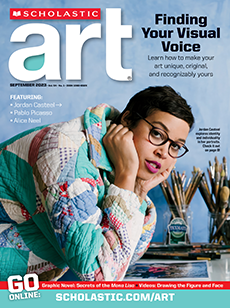Look around. Do you see an “EXIT” sign? If not, imagine one. The sign you see is probably red and white with big letters. It clearly marks the exit and can be read from far away.
Now imagine how useless the “EXIT” sign would be if it were designed with tiny, pale-yellow cursive letters.
The way designers style and arrange letters and numbers on a sign, printed page, or website is called typography. When designers work with type, they consider the message they need to convey—like clearly marking an exit. Similarly, artists can use type in their work to share a message or ask a question.
Can you picture an “EXIT” sign? It’s probably red and white with big letters. It clearly marks the exit. Now imagine an “EXIT” sign with small, pale-yellow letters. It would be difficult to read.
Designers think carefully about how to style letters and numbers on a sign, printed page, or website. This artform is called typography. Designers and artists use type to share messages or ask questions.
